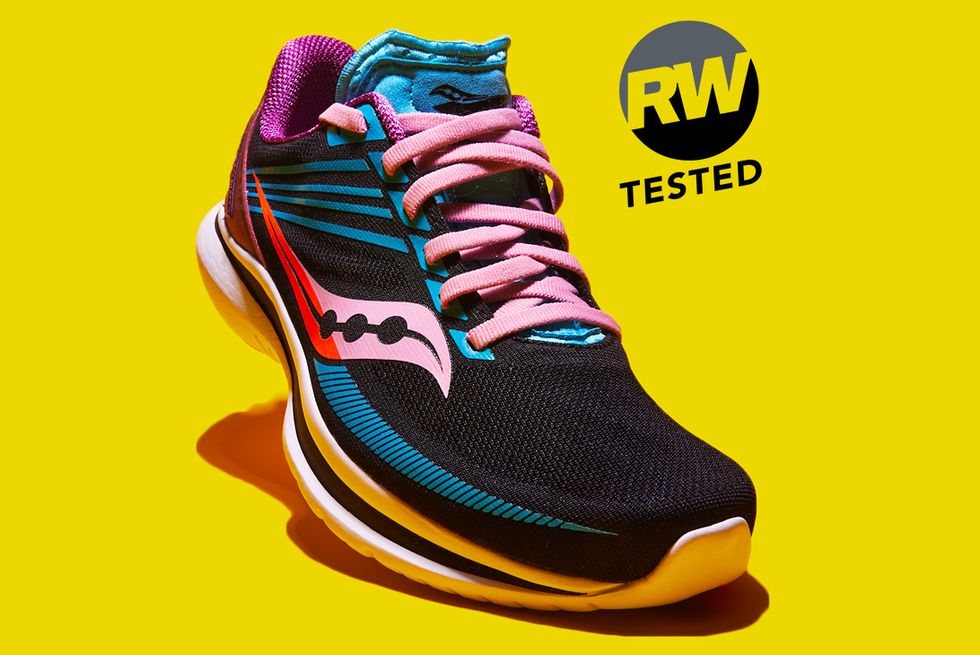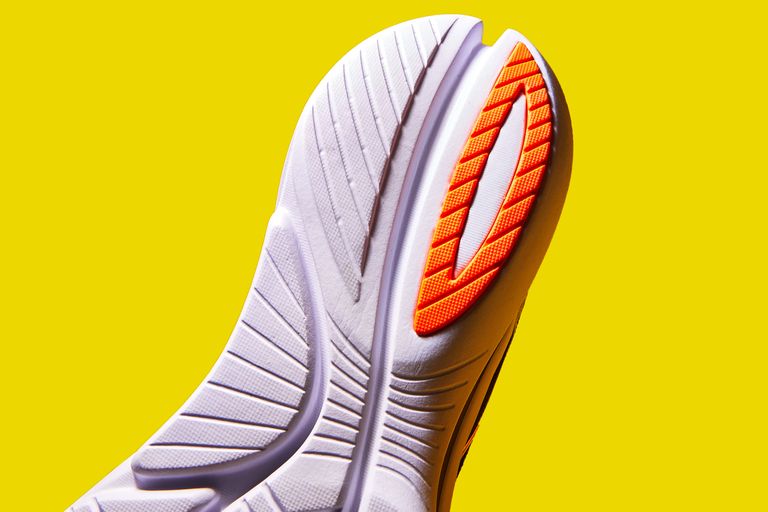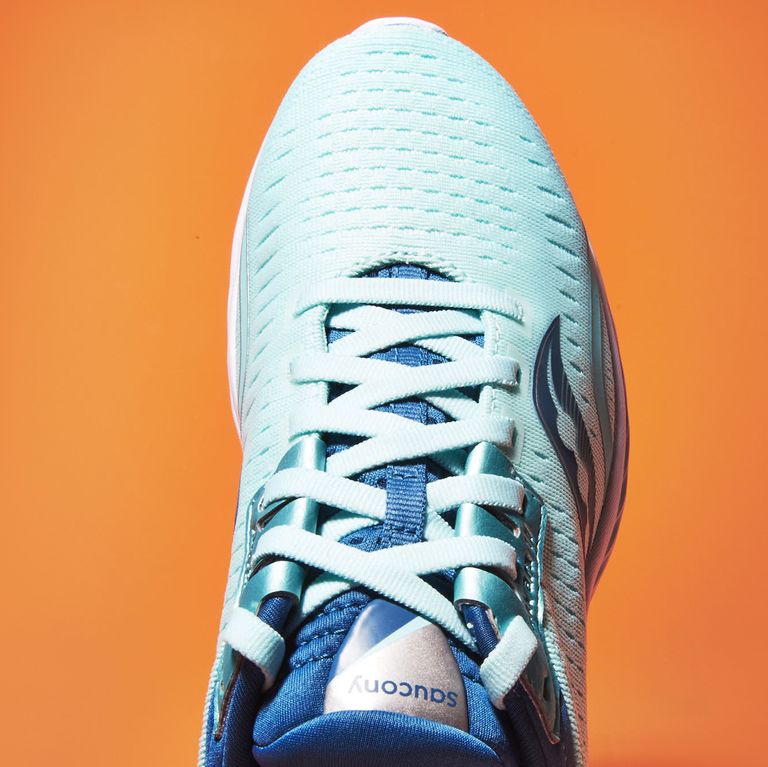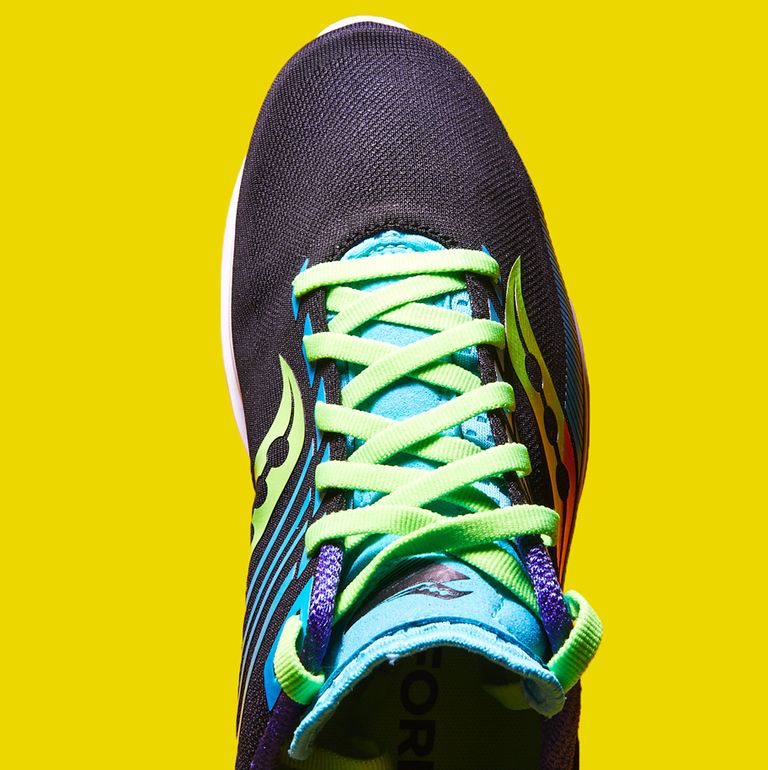
The RW Takeaway: Nimble and cushioned, the Kinvara is an excellent reminder that a simple shoe can still take you from speedwork to long runs at a stellar price.
- New midsole geometry and livelier foam make transitions feel smoother and quicker than the Kinvara 11.
- Styled after the Endorphin series, the upper uses a lighter, more breathable mesh.
- Reshaped outsole lugs improve traction on wet roads and for tight cornering.
Price: $199.99
Type: Road
Weight: 7.5 oz (M), 6.5 oz (W)
Drop: 4 mm
The 12th version is a fantastic homecoming for the Kinvara. After the 11 became stiffer and heavier—we got fairly strong “daily trainer” vibes from its super plush tongue and thick upper—the 12 nudges the Kinvara back toward its racer roots. It’s a touch lighter and much more flexible, like the shoe’s fledgling models, with a snugger mid-foot lockdown and new blend of Pwrrun foam. Saucony tweaked the foam’s mix of EVA and polymers to improve energy return, and while it doesn’t pack the punch of the Endorphin series, it does feel firmer and more responsive.
Powered by solemotive.com
(Free Aus express shipping on orders over $100)
Pros
- Lighter and more flexible than the Kinvara 11
- Slimmer midfoot fit improves lockdown and arch support
Cons
- Adequate cushioning for long runs, though some runners will want more softness
A slim layer of softer TPU-based Pwrrun+ sits on top to keep the shoe comfy as a daily trainer—long runs included. “All in all, the versatile cushioning is what makes the Kinvara my go-to. It’s lightweight, responsive, and can withstand a ton of kilometres,” one tester said. “Whether I’m going short or long, going out for a leisurely run or for speedwork and hills, this shoe is game.” Just don’t look too long at the exposed foam outsole—it’s sufficiently grippy for dry road running, but readily shows dirt and cosmetic wear after a few kilometres.

Built for Speed Day, and Beyond
At the risk of sharing a runner’s equivalent of the origin story before an online recipe, I promise to keep it quick. I started running in the Kinvara 4 when my college coach said we needed separate shoes for speedwork and tempos. I bought the Kinvara because it was the cheapest option at the campus run store, but I eventually found myself grabbing the shoes for daily runs and even long runs. The Kinvaras were on my feet pretty much any time I, a middle-of-the-packer, wanted to keep pace with the faster ladies on the team. That’s the similar appeal that comes with the Kinvara 12. Most every runner will jibe with the fast feel of the Kinvara on speed days, and based on how much cushioning you prefer, you might just get hooked on the shoe for longer distances. One very light and efficient tester who logs about 40 kilometres per week liked it for easy, daily efforts and long runs. Another found the cushioning not quite soft enough—especially when putting in 80+ kilometres weeks—and delegated it to track intervals.

LAKOTA GAMBILL
“Personally, I need lots of cushioning and support to prevent the nagging aches and pains I get from 45 years of running. The Kinvara is decent, as the cushioning does remain responsive for longer runs, but there just isn’t quite enough of it for me. I have found the Hoka Clifton works best for my current needs,” one tester said. For weekend long runs, I would agree, as I also appreciate a little more cushioning these days and a slightly higher drop. Regularly going long on a 4mm offset (when I’m accustomed to training in 8mm) shifts more effort onto my calves and Achilles.

LAKOTA GAMBILL

LAKOTA GAMBILL
Fresh Mono Mesh and a Slimmer Fit
The 12 owes much of its weight savings to Saucony shaving extra cushioning off the tongue and ankle collar. Neither I nor our testers missed it; the padding that remains is just enough for comfort, and in just the right areas for protection. The new perforated tongue is thin but not floppy, with suede-like cushion that relieves pressure from the lacing, and the snug inner gusset wraps the entire foot, keeping you locked in place. In addition, the waist of the shoe (right around the midfoot) is a touch narrower than that of the Kinvara 11. Some testers felt this better supported the arch, but those with wider feet or bunions found the overall tapered construction became more restrictive for longer distances when their feet swelled.
Two Testers’ Takes
Tim C. | Tester since: 2013
Arch: Medium | Gait: Neutral | Footstrike: Midfoot
“All in all, the cushioning is what I like most about the Kinvara. I gave the 12 an overall rating of ‘7 out of 7’ because it is everything that I look for in a shoe. It continues to be my lightweight and responsive go-to and I feel like I can put a ton of kilometres on a pair and they will still feel like they do in the beginning. (That said, I’m aware that my smaller body frame and running mechanics make it a little easier for the shoes to endure my ride.) The fabric around the toe box was breathable and minimal without any seams or extra fabric, and it had a stretch component to it that allowed my toes to move around freely. The lacing system also provided a nice snug fit that prevented the tongue from moving around or slipping down into the shoe.”
Trevor C. | Tester since: 2017
Arch: Medium | Gait: Neutral | Footstrike: Midfoot
“This shoe is a nice ride in the lightweight trainer category. It is quite light and feels comfortable on foot, but there is nothing about it that really distinguishes it for me. I felt like the amount of cushioning and support was a bit lacking; having worn a lot of the more modern, advanced foams lately in shoes like the Saucony Freedom or the Adidas Boost, the Kinvara’s EVA/TPU blend felt a bit underwhelming. I felt like I wasn’t receiving as much impact cushioning on longer runs when I started to feel like my muscles were working harder to handle the impact. Personally, I would not wear the Kinvara for runs over 12 kilometres.”